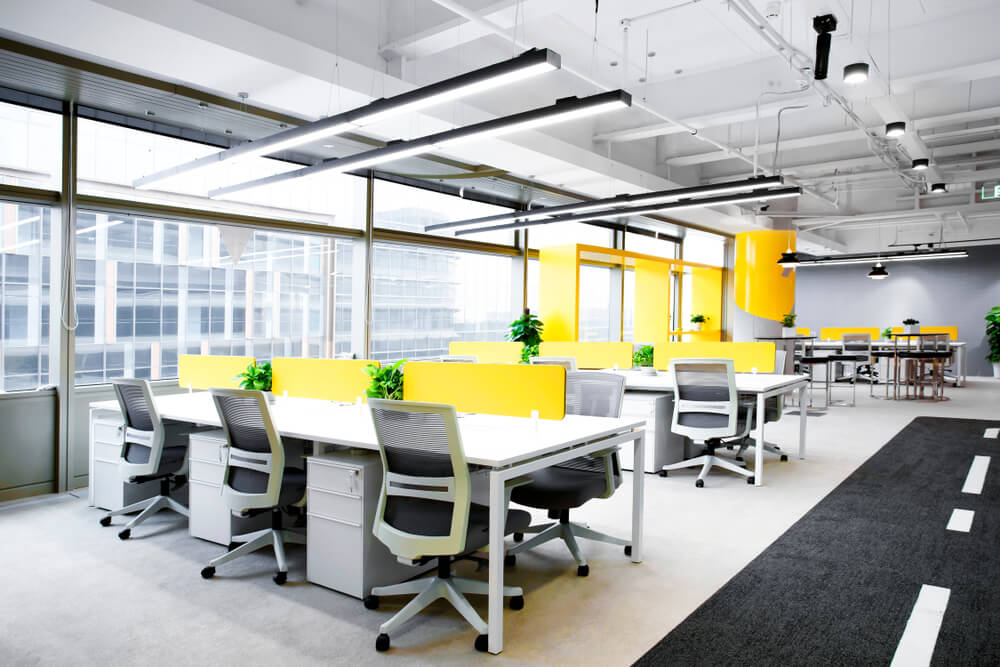Designing your Corporate Office Interior

Designing your Corporate Office Interior
Designing a functional, attractive corporate office space is essential for creating a productive work environment that reflects your company’s brand and culture.
Whether you’re moving into a new space or redesigning your existing office, there are several factors to keep in mind when it comes to corporate office interior design. From establishing different work zones to maximizing natural lighting, every element plays an important role in creating a comfortable and productive workspace.
In this guide, we’re going to set you up with some practical tips on how to design a corporate office space that will help to boost employee productivity, promote collaboration, reflect your company’s values – and be stylish at the same time.
Sustainability: Choosing Environmentally-Friendly Materials
As businesses become more environmentally conscious, sustainable office design has gained priority. It’s a trending topic in corporate office design. For a good reason – sustainable design can have many benefits, like reducing your company’s carbon footprint, providing a healthier workspace for employees, and even bolstering your reputation.
Sustainable office design can have a significant positive impact on the environment by minimizing energy consumption, reducing waste, and using eco-friendly materials. When selecting materials, consider those that are made from renewable resources or are recycled, such as bamboo or recycled plastic. Also, look for materials that are free from harmful chemicals, such as volatile organic compounds (VOCs).
In addition to its environmental benefits, sustainable office design can also improve employee health and well-being. Using health-conscious materials and indoor plants can boost air quality, reduce the risk of respiratory issues, and enhance productivity, leading to improved job satisfaction and retention rates.
Beyond the walls of your office, sustainable design can boost your company’s image and reputation, especially among customers and potential employees who prioritize environmental responsibility. A commitment to sustainability can help attract top talent, establish brand loyalty among eco-conscious customers, and demonstrate the company’s corporate social responsibility.
Comfort: Promoting a Relaxing and Productive Atmosphere
Creating a comfortable and inviting office space is essential to ensuring employee satisfaction and productivity. Especially in a time when working from home has become the norm, it has become more important than ever to create workspaces that employees enjoy as much as possible.
One of the simplest ways to improve comfort in corporate office design is to focus on ergonomics. This means designing workstations and office furniture that are adjustable and customizable to meet individual employee needs. Chairs that provide proper lumbar support and desks that can be adjusted to the right height can significantly reduce discomfort and even prevent long-term health issues such as back pain and repetitive strain injuries.
In addition to ergonomic design, it is crucial to consider other aspects of employee comfort, such as temperature and noise levels. Providing adequate temperature control, soundproofing, and proper ventilation can help employees feel more comfortable and focused.
Health and Safety: Prioritizing Your Employees’ Wellbeing
The health and safety of your employees should always be top of mind when designing your office space. This means ensuring that the space meets all health and safety regulations, including proper ventilation and lighting. It’s also important to consider the layout of the space to prevent accidents and ensure easy access to emergency exits.
Of course, going beyond the basic expectations for health and safety is always a good idea and can result in advantages for both employees and employers. For example, an air purification system can greatly add to your workspace. Employees obviously benefit from improved air quality, and the potentially reduced number of sick days – not to mention better morale – is a win for the employer as well.
Color Palette: Creating the Right Atmosphere
The color palette you choose for your office space can have a significant impact on your employees’ mood and productivity.
When selecting colors for a corporate office interior, consider the psychology of color and how different hues can affect mood and behavior. Neutral colors such as beige, gray, and white can create a calming and professional environment, while warmer colors like orange and red can stimulate creativity and energy. Cooler tones, like blue and green, can promote relaxation and concentration. It’s important to strike a balance between neutral and more vibrant colors to create a visually appealing workspace without overwhelming employees.
Consider the type of work that your employees do and select a color palette that compliments their work style as well as your brand.
Natural Lighting: Letting in the Sunshine
Natural lighting not only helps to reduce energy costs but can also improve your employees’ mood and productivity. Studies have shown that exposure to natural light can improve sleep quality and reduce stress levels, as well as help reduce eye strain and headaches.
When designing your office space, consider ways to maximize natural lighting, such as installing large windows or skylights. If you’re working with a layout that has minimal windows, look into utilizing transparent wall systems to create semi-private work areas without impeding natural light.
Functionality: Creating an Efficient and Productive Workspace
Of course, functionality is one of the most important factors to consider when designing your office space.
Your office should be designed to support your employees’ work style and daily tasks. This means creating designated work areas, providing adequate storage space, and ensuring that equipment is easily accessible. Additionally, consider the layout of the space to encourage collaboration and communication between employees.
Thanks to innovations in office interior design, there are many ways to increase the efficiency of a workspace – and do so with an approach that makes sense for the unique needs of your organization. Many companies are embracing flexibility with demountable walls, setting up a variety of spaces that serve separate needs: collaboration, individual work, hosting clients, and so on.
Pod-style office layouts are proving to be a smarter alternative to completely open workspaces, largely because they acknowledge (and satisfy) the constantly evolving needs of an organization and its employees.
Collaborative Office Interiors: Your Expert Partner in Corporate Interior Design
The best interior office spaces are those that achieve a balance of form and function, serving as an inviting, comfortable workspace that supports employee productivity and wellness alike. With the right approach, your office interior can be more than simply an appealing space; it can actually contribute to the success of your organization as a whole.
Collaborative Office Interiors provides commercial interior design services for a diverse range of company types and sizes, working closely with you to create a space that fits your needs and goals. From office space planning to installation, our team of skilled professionals is here for you at every stage of the process. And with our expansive selection of office furniture and accessories, we’ll ensure you have everything you need for your ideal corporate workspace.
For more information about how to design a corporate office – and how our commercial designers can help – contact Collaborative Office Interiors today.

John Ofield is the owner of Collaborative Office Interiors. Houston’s trusted source for premium office furniture, office cubicles, demountable walls, office desks and tables, and complete workspace solutions. With more than 40 years of experience, he combines deep product knowledge with hands-on space-planning expertise to create ergonomic, productivity-focused work environments for businesses across Southeast Texas.


